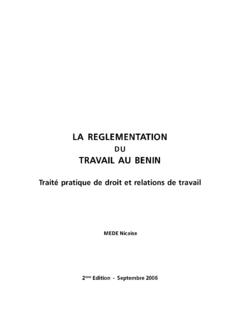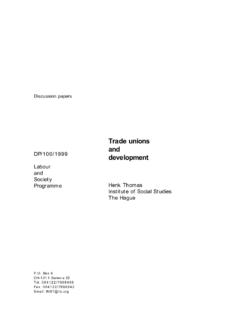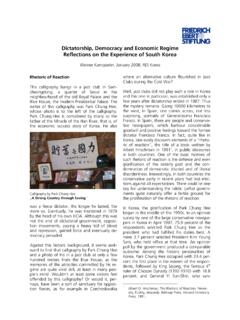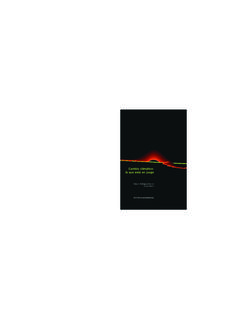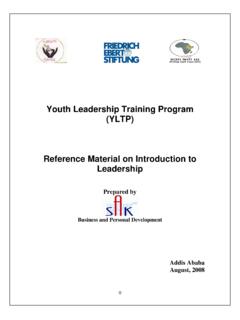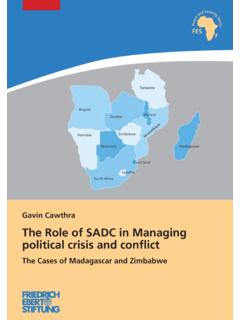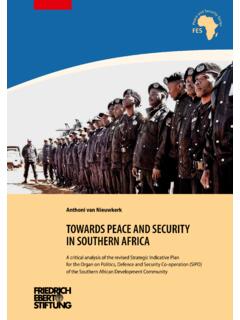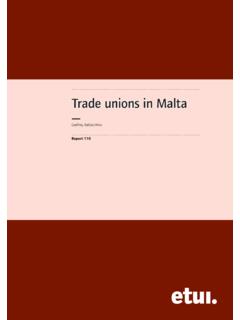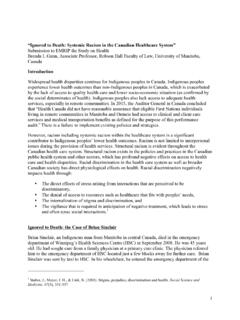Transcription of An Overview of the Gender Situation in the Philippines
1 An Overview of the Gender Situation in the Philippines Carlos Antonio Q. Anonuevo Friedrich-Ebert-Stiftung philippine Office September 2000. The Gender Situation in the Philippines is characterized by sharp About Us graphically showcases samples of women's advancement in politics, academic and Core Themes professional excellence, and even legislation. But this is contrasted by images of prostituted women, battered wives, economically disadvantaged women and exploited Activities migrant workers. Publications Online Materials The socio-cultural traditions are clashing with the MTV and cyberspace generation. The long history of colonialism has embedded a patriarchal culture among Filipinos. The conception of women as full-time homemakers, as subordinated to men, violence against them is private, as reserve labor force, and as sexual objects is now being eroded by modern women asserting themselves in many aspects of life.
2 But on the FES Dialogue on other hand, some are either marginalized, discriminated, or even exploited by the harsh Globalization realities of global economy and consumerism. FES International Policy Both the changes and the inertia of traditions are the backdrop of a very active and Analysis Unit dynamic women's movement. The Philippines is a main player in the international women's arena and this is anchored on a very vibrant local women's movement. FES Journal - Numerous organizations and NGOs exist for the cause of Gender equality and other International Politics and Society related women issues. This puts the Gender equality issues at the forefront of national discourse and precludes further downslide of women status in the modern philippine society.
3 Indeed, there are many handles for the changes to happen. These legal and policy gains resulted from the strong voice of women that started even during the anti-dictatorship struggle that culminated with the ascension of Corazon Aquino as the first woman president of the country. The 1987 Constitution states two prominent provisions. The first in the Declaration of Principles Article II Section 14 which asserted that "The State recognizes the role of women in nation-building and shall ensure the fundamental equality before the law of women and men." Additionally, the Article XIII-Labor: Section 14 provided that "The state shall protect working women by providing safe and healthful working conditions taking into account their maternal functions, and such facilities and opportunities that will enhance their welfare and enable them to realize their full potential in the service of the nation".
4 Following from constitutional provisions and the subsequent efforts to broaden the its principles, numerous legislation were enacted that relates to the various aspects of women and Gender concerns, The list include: z Gender and Development Law (5% of government agencies' budget is for Gender concerns). z Party-List Law (women as a particular sector for representation in the legislature through party-list elections). z Anti-Sexual Harassment Law (defining SH and providing mechanisms). z Anti-Rape Law (elevation of rape as crime against person). z Barangay Day Care Center Law (day care center for every village). z Women in Nation-Building Law (allocation of budget for women from development funds from foreign governments and multilateral institutions).
5 Z Anti Mail-Order-Bride Law (making the practice unlawful). z Repatriation Law (repatriation of Filipinas who lost citizenship by marriage in case of need). z Non-Discrimination Law in Labor Code (women protection in hiring and pay). z Comprehensive Agrarian Reform Law (equal rights for women to be recipients of land). z Military Training equality (women can enter the military and police schools and providing facilities for them). While the legal framework is there, the actual Situation mirrors the deep Gender divide. In the aspect of women in politics, the notable success of several women is overshadowed by the actual ground level statistics. The lady Vice-President is up to now a shoo-in in the next presidential elections in 2004.
6 But the big picture shows that of all the elective positions occupied through the 1998. elections, only 15% are women. In the two-chamber Congress, the Senate (Upper House) has women membership (4 out of 23 seats) which the House of Representatives (Lower House) has (27 out of 217 seats). The first party-list elections in 1998--wherein sectoral groups like women competed to get a maximum of 3 seats per party in the House of Representatives--resulted in the winning of one (1) seat for a single women's party. Five (5) other women's party did not make the minimum votes required. At the local government level, women provincial Governors constitute 17% while Vice- Governors are at level. Among the City and Town Mayors, of them are women while the ranks of the Vice-Mayors are at low of The labor force statistics show also a mixed picture.
7 Since there was a notable feminization of the workforce in the past years, July 2000 figures showed that there are million unemployed women while there are million unemployed men. However, more women are taken in for labor flexibility arrangements especially in the big services sector like in retail trade. This leaves them exposed to employment insecurity and unfair compensation schemes. Women still accounts for 53% of the unpaid family workers while they constitute only of the wage and salary earners. Though this shows that the regular income possibilities for women are still limited, the average household annual income of female-headed families is higher. The Situation also pushes them to seek employment overseas. Increasing numbers of domestic helpers and entertainers are also being deployed both legally and illegally.
8 Within organizations, the Gender balance is under overhaul. Trade union leadership is still male-dominated but women committees and affirmative actions have changed the complexion of decision-making. The public sector unions have made great inroads as four (4) of the major federations are under the strong leadership of women. However, the social fabric remains tainted by arrogance of male power. Police statistics remains indicative of the traditional ways of how women are seen in the social and family context. In 1998, 6,518 cases of violence against women were reported with rape accounting for 1,054 cases and physical injuries at a high of 2,633 cases. Last year, the former was pegged at and the latter reached of the cases reported.
9 In response to problems that continue to face the Filipina, numerous civil society groups were organized and pioneering projects were initiated. The vocal women's movement was instrumental in the enactment of the laws that seek to protect women and broaden their role in the society. Sub-sectoral groupings of women guaranteed the articulation of specific interests and agendas while issue-based networks and coalitions advocated and lobbied to policy-makers and legislators. The campaign for the sexual harassment and the anti-rape laws saw the synergy of the different organizational forms within the women's movement. Their current engagement deals with the law that deals with domestic violence, abortion and divorce. Such advocacy work is also complemented with concrete projects at the ground level.
10 Community-based groups tackle violence against women, rural and urban women establish economic undertakings that help them increase their income, wives and families of migrant workers establish their own savings and insurance network, and crisis centers are organized in some parts of the country. Even prostituted women have found both protection and solidarity within their organizations. These activities have seen successes and failures but they constitute as challenges to the socio-cultural bondage and blinders that up to this age of Internet and globalization has victimize the Filipina. The Gender Situation in the Philippines can be describe in sum as: 1. The legal framework has provided basic frameworks and processes for women empowerment and Gender fairness but the dynamics of political and social institutions reinforced by the cultural standpoints continue to provide a push-pull effect on Gender equality.

